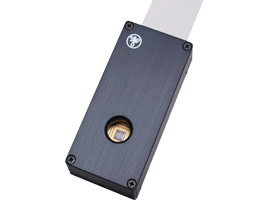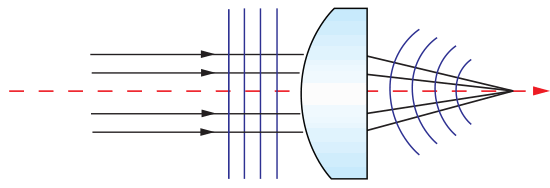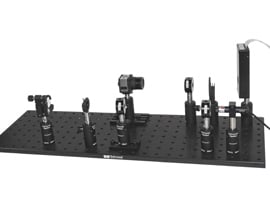Introduction to Adaptive Optics and Deformable Mirrors
Understanding Wavefronts | Adaptive Optical Elements and Systems | Key Parameters| Applications

In optical systems misalignment of components, imperfections in elements, or aberrations can internally reduce performance, while heat and atmosphere can externally reduce performance. Although careful design of an optical system can reduce these problems, performance impairments may be too severe to solve with conventional methods. For example, in astrophotography, a field in which it is difficult to control external factors such as atmospheric disturbance, active methods are used for correcting performance. The key in both macro astronomy applications and micro optical applications is adaptive optical (AO) elements including deformable mirrors like the Iris AO 111 Actuator Deformable Mirror.
Understanding Wavefronts
Adaptive optics (AO) is a technology used to enhance the performance of an optical system by manipulating the optical wavefront. This improves the final output, improving performance compared to a non-adaptive system. A wavefront is defined as a surface associated with a propagating wave passing through all points that have the same phase. Undistorted wavefronts are typically planar or spherical, and can be changed with the use of common optical elements. For example, a positive lens focuses collimated light to a point, transforming a plane wavefront to spherical wavefront as illustrated in Figure 1.
Employing an active means of manipulating a wavefront with adaptive optical elements like a deformable mirror provides precise control of the shape of the wavefront. This precision and “programmable” control, unobtainable by non-adaptive elements, leads to dramatic improvements in the performance of many optical systems. This is why adaptive optics is employed in a broad range of imaging and non-imaging applications to reduce aberrations, improve image quality or shape laser beams. For more information on aberrations and how to correct for them, please read Chromatic and Monochromatic Optical Aberrations.

Figure 1: Plano-Convex (PCX) Lens Changing Plane Wavefront to Spherical Wavefront
Adaptive Optical Elements and Systems
Adaptive optics corrects a wavefront by using an optical element that changes shape when an outside control signal is applied. A deformable mirror is an adaptive element with a controllable reflective surface shape. By introducing the correct mirror shape, a distorted input wavefront can be improved as illustrated in Figure 2.

Figure 2: Deformable Mirror Correcting a Distorted Wavefront
The mirror shape can be derived from a set of pre-calculated or stored shapes, i.e., open loop control, or can be calculated based on feedback from a wavefront sensor and operate in closed loop control.
A simple open loop adaptive optical imaging system is shown in Figure 3a. The system is comprised of a deformable mirror, mirror control electronics, imaging sensor, and conventional optical elements. The control system operates open loop and can apply predetermined mirror shapes to correct for different types of aberrations for example. This same system can also be used to introduce known optical aberration into a system to gain an understanding of their impact on system performance.

Figure 3a: Adaptive Optical System using a deformable mirror running in open loop control
A more sophisticated system employs a wavefront sensor (described below) capable of characterizing the shape of an incident wavefront. A beam splitter is placed in the optical path and used to reflect part of the light onto a wavefront sensor as illustrated in Figure 3b. The information derived from this sensor is used to calculate the shape of the mirror needed to correct any wavefront distortion. This data is then fed back into the control system of the mirror which in turn changes the shape of the mirror. This system is a closed loop system and can continuously sample and measure the wavefront quality and feedback this information to control the mirror shape.

Figure 3b: A deformable mirror in an adaptive optics system operating in a closed loop configuration using feedback from a wavefront sensor to control the mirror shape.
A common type of wavefront sensor is the Shack Hartmann Wavefront Sensor. This sensor is fabricated with a microlens array mounted in front of a CCD or CMOS detector array as illustrated in Figure 4. As shown in Figure 4a, when a plane wavefront is incident on the sensor, each lenslet focuses the light in the center of a predefined set of pixels in the array that is placed at the focal plane of the lenslet array. When a distorted wavefront is incident on the microlens array, the focus spots are in different locations within the pixels associated with each lenslet as shown in Figure 4b. By analyzing the locations of the individual spots on the detector array it is possible to characterize the shape of the wavefront incident on the wavefront sensor. This information can be used to determine the shape of the deformable mirror surface needed to correct the distortion.
 Figure 4: Illustration showing the basic operating principals of the Shack Hartmann Wavefront Sensor
Figure 4: Illustration showing the basic operating principals of the Shack Hartmann Wavefront SensorKey Adaptive Optics Parameters
Surface type, segmented vs. continuous membrane, actuation technology, number of actuators, coating types and optical element dimensions are key adaptive optics parameters. Understanding these parameters enables the user to choose the adaptive optical element that best suits the application of interest. Table 1 summarizes four key adaptive optics parameters to consider when choosing a deformable mirror for a given application.
| Table 1: Key Adaptive Optical Mirror Parameters |
|---|
| Surface Type: Deformable mirrors can either be segmented or continuous. Segmented mirrors have many smaller mirror sections that can be controlled individually. The larger the number of segments, the more precise the control of the mirror shape. Continuous membrane mirrors consist of a single surface that can be deformed at different spots. |
|
Actuation Technology: Continuous surface deformable mirrors use actuators behind the reflective surface to deform it into the necessary shape. There are several options ranging from mechanical actuator posts behind the reflective membrane that shape the membrane, to magnets or piezoelectric elements to change the mirror surface profile. |
| Number of Actuators: The number of actuators defines the quality and the quantity of unique shapes the mirror can produce. As the number of actuators increases, so does the versatility in deformation. Typically, the number of actuators ranges from several tens to hundreds. |
| Dimensions: Deformable mirrors can range from a few millimeters in diameter to hundreds of centimeters. Their range in size makes them ideal for micro and macro applications. |
Application Examples

Adaptive optics are used in many imaging and non-imaging applications, including 3D imaging, vision, and biomedical applications. 3D imaging uses deformable mirrors to increase depth range, creating truer 3D. In vision applications, adaptive optics are used in robotic vision and surveillance cameras to provide real time or long-distance imaging. In microscopy, adaptive optics correct for aberrations in static lenses. Biomedical applications, including ophthalmology, use adaptive optics to overcome aberrations caused by the vitreous humor in the human eye in order to capture high resolution retinal images, or to increase depth of scanning in optical coherence tomography.
Adaptive optics are also found in several non-imaging applications, including laser materials processing, where they can be used to control laser beam shape and size to increase accuracy.
Adaptive optics are ideal for correcting wavefront distortions in imaging and beam shaping in non-imaging applications. Key optical components in any adaptive optical system are the deformable mirror and a wavefront sensor. When used in an open-loop system, these adaptive components shape lasers, or enhance imaging performance with aberration correction. If simple open loop control does not yield the desired performance consider pairing the adaptive element with a wavefront sensor in a closed loop control system. Begin exploring the performance improvement delivered by adaptive systems with the Iris AO Adaptive Optics Kit.













혹은 지사별 연락처 확인
견적 도구
재고번호 입력 후 바로 시작
Copyright 2023, 에드몬드 옵틱스 코리아 사업자 등록번호: 110-81-74657 | 대표이사: 앙텍하우 | 통신판매업 신고번호: 제 2022-서울마포-0965호, 서울특별시 마포구 월드컵북로 21, 7층 (서교동 풍성빌딩)